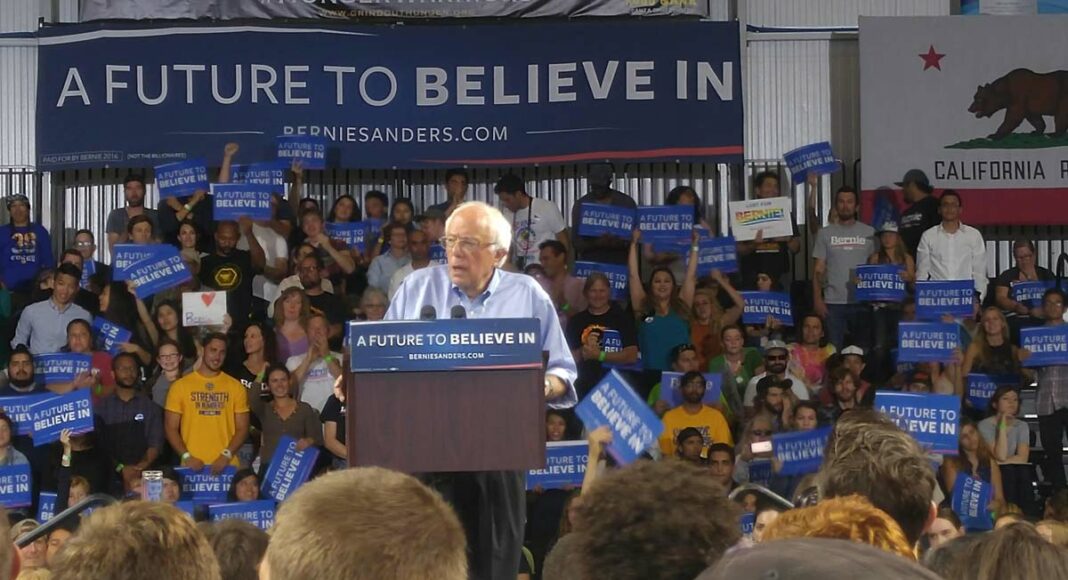Spirits were high as Santa Cruzans feeling the Bern trickled their way into the Kaiser Permanente stadium at 10:30 a.m. on Tuesday.
In true Santa Cruz fashion, drum circles thundered through the line, which stretched across the Laurel Street bridge, over the San Lorenzo River, and past the Ken Wormhoudt Skate Park to Ocean Street. Along the sidewalk, hints of sage wafted through the air as people waited to hear Democratic presidential candidate Bernie Sanders speak. Resounding cheers sporadically broke through the audience, as did yawns from sleepy-eyed Bernie fanatics, some who had waited in line since 5 a.m. or even the night before.

The diverse crowd—filled with young and old, yuppies and hippies—pulsed with electric enthusiasm as “Bernie 2016” flashed on the video screen opposite the stage. As security officials cleared wristband holders, the floor space filled and the crowd began to dance. By noon, the wave began, rippling from one end of the room and back.
One Berner, Chris Carlson, dressed up as the candidate, donning a balding wig with wild white hair, a suit and glasses. Carlson—who switched political parties to vote for Sanders and has since converted others to do the same—says the candidate is a serious contender.
“He represents a challenge to a party that’s supposed to be breaking from tradition to move society forward,” he said. “However, at this point, the Catholic Church is more progressive [than the Democratic Party] on some issues.”
Sanders was scheduled to take the stage at 1 p.m., but the U.S. senator from Vermont took a detour to speak to the hundreds of supporters outside the stadium, unable to get in. Inside, no one seemed to mind as more and more chants of “Bernie! Bernie” rose from the bleachers. As Sanders addressed those outside, Watsonville Mayor Felipe Hernandez took to the stage to introduce the man of the hour.

“Is Santa Cruz feeling the Bern?” he asked twice. “I’m the Mayor of Watsonville and I’m proud to say I’m ‘Feeling the Bern!” he added, pushing the crowd to feverish levels of excitement.
Hernandez told the audience that he supports Sanders on all issues. Born and raised in Watsonville, Hernandez is the son of working class parents who made daily, personal sacrifices so that their children could have a better life. “And to this day, that’s what has motivated me to serve my community and to bring a better quality of life to working people,” he said to raucous cheers.
When the Vermont senator walked onstage, not a single voice appeared to be silent in a crowd of more than 2,500, waving official “Bernie Sanders For President” signs in the air. Even the candidate couldn’t help but mention the commotion.
“This is a very loud crowd,” he joked, adding, “I hope the scientists don’t think there’s an earthquake happening.”
Audience members in the bleachers responded by stomping their feet with glee.
Sanders is in the middle of a Bay Area push filled with speaking engagements, to prepare for the California Primary on Tuesday, June 7.

Sanders, who holds the record as the longest-running independent senator in U.S. history, has campaigned for the Democratic Party nomination on a campaign largely based on income equality. Sanders’ campaign has been sponsored through a grassroots movement of American citizens donating roughly $30 each on average.
“A rigged economy is when the top one-tenth of the 1 percent owns almost as much as the bottom 90 percent,” he decried, as the crowd booed in anger. “The wealthiest 20 people in America are now wealthier than the bottom half of Americans—150 million people.”
It’s a message that seems to resound with many. “[Our country] is being run by corporations,” said Scotts Valley resident, Laura Rockow. “We want a democracy, not a ‘corporatocracy,’ and he’s for democracy.”
Throughout the hour-long speech, Sanders spoke on other “hot button” issues, such as climate change and the drug war—he supports legalizing marijuana. He also touched on his calls for free college tuition and single-payer healthcare for all—two controversial topics that he’s brought to the forefront of national politics. According to the senator’s plan, free higher education would be paid for by an increase in the corporate tax rate, along with the closing of tax loop-holes.
Part of Sanders’ appeal, some say, is his attention to less-discussed issues that affect many minority populations. “He’s the only candidate discussing Native American rights, which have been looked over in the past,” says Abigail Grattidge, a Cabrillo College student.
But the most important word was one that has fueled Sanders’ historic campaign, along with so many civil and labor movements before it, was “revolution.” In his speech, Sanders challenged democrats to show up and support their candidates in midterm elections—something that didn’t happen in 2010 and 2014, when the party suffered congressional losses they had gained in 2008.
“The political revolution that we talk about is not about me, it’s about you,” Sanders said. “We have got to create a political movement in which millions of people stand up, fight back, and make certain we have a government that listens to us and not just the 1 percent.”
A short video from the event:













